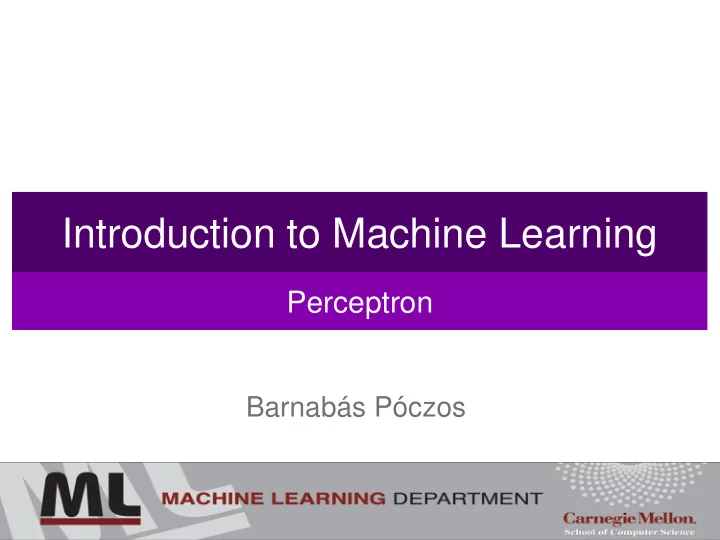

Introduction to Machine Learning Perceptron Barnabás Póczos
Contents History of Artificial Neural Networks Definitions: Perceptron, Multi-Layer Perceptron Perceptron algorithm 2
Short History of Artificial Neural Networks 3
Short History Progression (1943-1960) • First mathematical model of neurons ▪ Pitts & McCulloch (1943) • Beginning of artificial neural networks • Perceptron, Rosenblatt (1958) ▪ A single neuron for classification ▪ Perceptron learning rule ▪ Perceptron convergence theorem Degression (1960-1980) • Perceptron can’t even learn the XOR function • We don’t know how to train MLP • 1963 Backpropagation … but not much attention… Bryson, A.E.; W.F. Denham; S.E. Dreyfus. Optimal programming problems with inequality constraints. I: Necessary conditions for extremal solutions. AIAA J. 1, 11 (1963) 2544-2550 4
Short History Progression (1980-) • 1986 Backpropagation reinvented: ▪ Rumelhart, Hinton, Williams: Learning representations by back-propagating errors. Nature , 323, 533 — 536, 1986 • Successful applications: ▪ Character recognition, autonomous cars,… • Open questions : Overfitting? Network structure? Neuron number? Layer number? Bad local minimum points? When to stop training? • Hopfield nets (1982) , Boltzmann machines,… 5
Short History Degression (1993-) • SVM: Vapnik and his co-workers developed the Support Vector Machine (1993). It is a shallow architecture. • SVM and Graphical models almost kill the ANN research. • Training deeper networks consistently yields poor results. • Exception: deep convolutional neural networks, Yann LeCun 1998. (discriminative model) 6
Short History Progression (2006-) Deep Belief Networks (DBN) Hinton, G. E, Osindero, S., and Teh, Y. W. (2006). • A fast learning algorithm for deep belief nets. Neural Computation, 18:1527-1554. Generative graphical model • Based on restrictive Boltzmann machines • Can be trained efficiently • Deep Autoencoder based networks Bengio, Y., Lamblin, P., Popovici, P., Larochelle, H. (2007). Greedy Layer-Wise Training of Deep Networks, Advances in Neural Information Processing Systems 19 Convolutional neural networks running on GPUs Alex Krizhevsky, Ilya Sutskever, Geoffrey Hinton, Advances in Neural 7 Information Processing Systems 2012
The Neuron 8
The Neuron – Each neuron has a body, axon, and many dendrites – A neuron can fire or rest – If the sum of weighted inputs larger than a threshold, then the neuron fires. – Synapses: The gap between the axon and other neuron’s dendrites. It determines the weights in the sum. 9
The Mathematical Model of a Neuron 10
Typical activation functions • Identity function • Threshold function (perceptron) • Ramp function 11
Typical activation functions • Logistic function • Hyperbolic tangent function 12
Typical activation functions Rectified Linear Unit (ReLU) • Softplus function • (This is a smooth approximation of ReLU) Leaky ReLU • Exponential Linear Unit • 13
14
15
Structure of Neural Networks 16
Fully Connected Neural Network Input neurons, Hidden neurons, Output neurons 17
Layers, Feedforward neural networks Convention: The input layer is Layer 0. 18
Multilayer Perceptron • Multilayer perceptron: Connections only between Layer i and Layer i+1 • The most popular architecture. 19
20
Recurrent Neural Networks Recurrent NN : there are connections backwards too. 21
The Perceptron 22
The Training Set 23
The Perceptron 24
The Perceptron 1 -1 25
Matlab: opengl hardwarebasic , nnd4pr
Matlab demos: nnd3pc 27
The Perceptron Algorithm 28
The Perceptron algorithm The perceptron learning algorithm 29
The perceptron algorithm Observation 30
The Perceptron Algorithm How can we remember this rule? An interesting property: we do not require the learning rate to go to zero! 31
The Perceptron Algorithm 32
Perceptron Convergence 33
Perceptron Convergence 34
Perceptron Convergence Lemma Using this notation, the update rule can be written as Proof 35
Perceptron Convergence Lemma 36
Perceptron Convergence 37
Lower bound 38
Upper bound Therefore, 39
Upper bound Therefore, 40
The Perceptron Algorithm 41
Take me home! History of Neural Networks Mathematical model of the neuron Activation Functions Perceptron definition Perceptron algorithm Perceptron Convergence Theorem 42
Recommend
More recommend